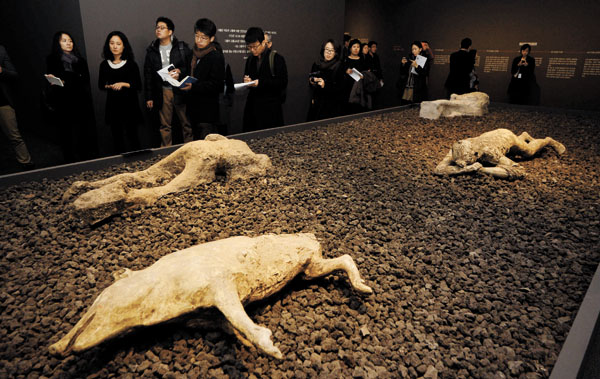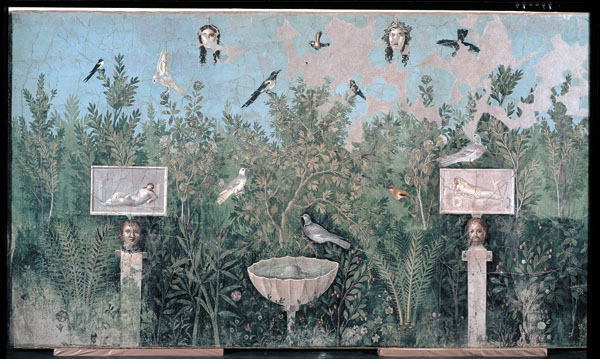Museum presents pieces from Pompeii

At the exhibition, “Pompeii: Culture of the Ancient Roman City,” visitors can see casts of humans and animals that perished on the day Mount Vesuvius erupted. [NEWSIS]
This is the first show in Korea dedicated to Pompeii since 1997. Back then, the exhibition was on a smaller scale, displaying mostly sculptures. The latest exhibition is larger, featuring about 300 sculptures, frescoes, paintings, pieces of jewelry and furniture, and kitchen utensils. But the showstopper is the casts of humans and animals.

Frescos are highlights of the exhibition at the National Museum of Korea. They show the luxurious lifestyles the people of Pompeii led when the city flourished. Provided by the museum
Pompeii was buried under tons of ash, which meant it was preserved because of the lack of air and moisture. It remained untouched for about 1,500 years, meaning that the discoveries made at the site encapsulate its very moment of demise with startling detail.

This bracelet, one of jewelry on display, has an engraving in Latin, “From master to slave.”
The exhibition, titled “Pompeii: Culture of the Ancient Roman City,” begins with a reconstruction of a typical Pompeiian house, which revolves around an atrium - a spacious central hall with gardens and fountains. Homes in the city were often decorated with frescos, which usually depicted landscape or myths, and statues.
Fifteen large frescos - which measure on average somewhere between 200 to 300 kilograms (441 to 661 pounds) each - have been brought to Korea for the exhibition.
A section dedicated to jewelry, cosmetics and accessories is also of interest as it provides a glimpse into the luxurious lifestyle led by the Pompeiians. While Roman law mandated that men were only allowed to wear one type of jewelry, a single signet ring, that was not the case for the women of the city.
Relics show that Pompeiian females decorated their hair with several accessories, wore necklaces and rings of various sizes and put on makeup. Intriguingly, a bracelet with the Latin engraving “From master to slave,” indicating an intimate relationship between people from opposing social classes, can also be seen in this section.
A segment dedicated to Pompeii’s final days displays the casts of humans and animals in a reconstruction of the tragic day when the flourishing city was obliterated. A man is seen crouching after apparent suffocation. A dog seems to twist his body in pain.
“The excavation team [led by Giuseppe Fiorelli] kept finding relics and sometimes even bones from cavities in Pompeii,” Gu Moon-gyoung, the museum’s curator says, “and when they poured plaster into the voids they found forms of humans as well as animals and plants that perished in the eruption.”
The exhibition also has an R-rated element, where relics and images considered obscene today are shown. Museum officials explained that sexual customs differed at the time and that erotic paintings and mosaics were found in private houses as well as public places.
“Pompeii: Culture of the Ancient Roman City” runs until April 5 at the National Museum of Korea in Yongsan District, central Seoul. Admission is 13,000 (about $12) for adults; 11,000 won for middle school, high school and university students; 8,000 won for elementary students; and 5,000 won for preschoolers. Go to Ichon Station (lines No. 1 and 4), exit 2.
BY KIM HYUNG-EUN
[hkim@joongang.co.kr]










with the Korea JoongAng Daily
To write comments, please log in to one of the accounts.
Standards Board Policy (0/250자)